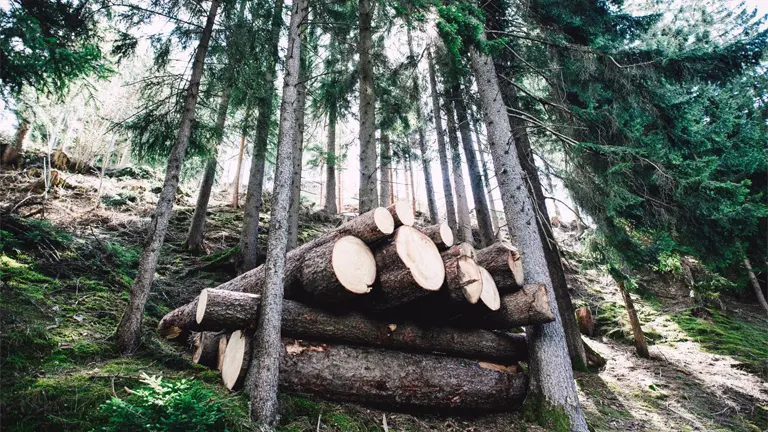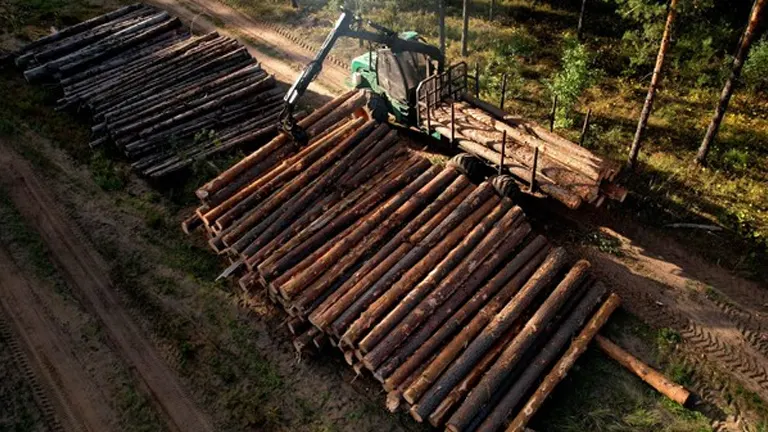Forestry and Logging Global Market Report 2025
- September 11, 2024
- 0 comment
The forestry and logging sector represents a crucial part of the global economy, providing raw materials for a multitude of industries, including paper manufacturing, construction, and energy. The industry’s primary activities involve growing, harvesting, and managing forests for timber, pulpwood, and other wood products.

As the world grapples with the need for sustainable practices, the role of forestry in maintaining biodiversity and mitigating climate change has gained increasing prominence. The Forestry and Logging Global Market Report 2025 explores the intricate details of this sector, evaluating its market dynamics, growth drivers, challenges, and future outlook.
Historical Forestry and Logging Global Market Context (Pre-2025)
Historically, the forestry and logging industry has been shaped by evolving societal needs, environmental considerations, and economic growth. Over the past few decades, the global demand for wood products has grown steadily due to urbanization, population growth, and rising consumption of paper and packaging materials. However, the sector has also faced significant scrutiny for its role in deforestation, particularly in regions like the Amazon, Southeast Asia, and Central Africa. This has led to a balancing act between maximizing economic output and adhering to stricter environmental regulations. The pre-2025 period set the stage for emerging trends that would shape the industry’s future.
Forestry and Logging Market Size in 2025
In 2025, the global forestry and logging market is projected to reach a substantial size, reflecting the ongoing demand for wood products, coupled with increasing investment in sustainable forestry practices. According to estimates, the market value will surpass $1,072.53 Billion, driven by growth in key regions such as North America, Europe, and the Asia-Pacific.
| Segment | Percentage of Total Market | Market Value (in Billion USD) |
|---|---|---|
| Logging (Timber) | 45% | $482.64 Billion |
| Pulpwood | 30% | $321.76 Billion |
| Firewood | 15% | $160.88 Billion |
| Other Non-Timber Products | 10% | $107.25 Billion |
| Total Market Value | 100% | $1,072.53 Billion |
This growth is buoyed by increased demand for timber, paper, and bioenergy products, alongside the advent of innovative forestry techniques aimed at enhancing sustainability. As countries push for greener economies, forestry’s role in carbon sequestration and ecosystem management is becoming more critical.
Market Segmentation and Analysis
The forestry and logging market can be segmented based on product types, including logging (timber harvesting), pulpwood, firewood, and other non-timber forest products. Logging, in particular, dominates the sector, accounting for over 8.4% of total market revenue.
| Segment | Percentage of Total Market | Market Value (in Billion USD) | Contribution to Total Cost (8.4%) |
|---|---|---|---|
| Logging (Timber) | 45% | $482.64 Billion | $40.54 Billion |
| Pulpwood | 30% | $321.76 Billion | $27.03 Billion |
| Firewood | 15% | $160.88 Billion | $13.51 Billion |
| Other Non-Timber Products | 10% | $107.25 Billion | $9.01 Billion |
| Total Market Value | 100% | $1,072.53 Billion | $90.09 Billion |
Timber and pulpwood are the most significant contributors, with growing demand from the construction, paper, and packaging industries. Additionally, regional segmentation reveals varying market dynamics, with North America and Europe focused on sustainable forestry management, while emerging markets in Asia and Africa experience rapid growth due to increased logging activities to meet domestic and export demands.
Geographical Insights: Regional Market Overview

- North America: The forestry industry in North America, particularly in Canada and the United States, remains a global leader in sustainable forest management practices. These nations are also among the largest exporters of timber and paper products.
- Europe: European countries, especially Finland, Sweden, and Russia, are key players in the forestry market, driven by robust demand for bioenergy and pulpwood. The EU’s emphasis on sustainability further influences this region’s market structure.
- Asia-Pacific: China and India lead the Asia-Pacific market, with significant logging activities aimed at supporting the construction boom and paper production. Indonesia and Malaysia, while smaller markets, play a crucial role in global pulpwood supply.
- Africa and Latin America: These regions are experiencing rapid growth in logging activities, fueled by demand from international markets. However, deforestation and illegal logging pose significant threats to long-term sustainability.
Key Market Drivers and Restraints
Several factors contribute to the growth of the global forestry and logging market in 2025. Key drivers include:

- Rising Global Demand for Wood Products: The construction industry’s boom, along with increased paper and packaging needs, drives timber demand.
- Technological Advancements: Innovations such as drones, satellite monitoring, and AI-powered forest management tools improve operational efficiency and forest conservation.
- Sustainability Initiatives: Growing awareness of climate change has led to investments in sustainable forest management practices and certified timber production.
However, the industry faces significant challenges, including:
- Deforestation and Climate Change: Unsustainable logging practices, deforestation, and the resulting loss of biodiversity are critical concerns for the industry.
- Regulatory Hurdles: Stricter government regulations on timber harvesting and environmental conservation efforts can limit industry growth.
Impact of Environmental Sustainability in 2025
Environmental sustainability is no longer just a trend but a necessity in the forestry and logging industry. In 2025, companies are increasingly adopting sustainable forest management (SFM) practices to balance ecological health with economic profitability.

Certifications like FSC (Forest Stewardship Council) and PEFC (Programme for the Endorsement of Forest Certification) ensure that timber is sourced responsibly, preserving biodiversity and reducing carbon emissions. Sustainable forestry is also seen as a key player in climate change mitigation, with forests acting as carbon sinks to absorb CO2 from the atmosphere.
Role of Technology in Forestry and Logging
Technology is transforming the forestry and logging sector, enhancing both productivity and sustainability. Smart forestry involves the use of data analytics, AI, and remote sensing technologies to manage forests more efficiently. Drones are used for aerial surveillance, helping to detect illegal logging, monitor forest health, and improve resource allocation.

Additionally, automation in logging operations reduces labor costs and increases precision, allowing for more sustainable harvesting techniques. The integration of digital platforms also facilitates real-time monitoring of forest ecosystems, ensuring that logging activities comply with environmental regulations.
Key Players and Market Competition
The global forestry and logging market is highly competitive, with several large players dominating the space. Leading companies such as Weyerhaeuser, International Paper, and Stora Enso continue to hold significant market shares due to their vast forest holdings and focus on innovation. These companies are investing heavily in technology to improve operational efficiency and promote sustainable practices. Additionally, local players in emerging markets are gaining ground, fueled by increased demand for wood products and favorable government policies that encourage logging activities.
Global Trade Dynamics and Export Markets
The international trade of forestry and logging products is a key driver of the industry’s growth. Major export markets include timber, pulp, and paper, with significant trade flows between North America, Europe, and Asia.
| Region | Export Percentage | Market Value (in Billion USD) |
|---|---|---|
| North America | 35% | $375.38 Billion |
| Europe | 30% | $321.76 Billion |
| Asia-Pacific | 20% | $214.51 Billion |
| Latin America | 10% | $107.25 Billion |
| Africa | 5% | $53.63 Billion |
| Total Global Exports | 100% | $1,072.53 Billion |
The United States and Canada are leading exporters, supplying timber to markets across Europe and Asia. Meanwhile, countries like China and India are the largest importers, driven by domestic construction and manufacturing demands. However, trade barriers, tariffs, and import restrictions in some countries pose challenges to the free flow of timber products.
Government Regulations and Policies
Governments across the globe have introduced stringent regulations to promote sustainable forestry and curb deforestation. These include forest management policies, logging quotas, and restrictions on the export of raw timber. International agreements such as the Paris Climate Accord and the REDD+ program (Reducing Emissions from Deforestation and Forest Degradation) aim to reduce the environmental impact of logging while supporting sustainable development. Countries are increasingly adopting these policies to balance economic growth with ecological preservation, ensuring the long-term viability of forest resources.
Market Forecasts and Growth Projections (2024-2030)
The forestry and logging market is expected to grow steadily through 2030, with a compound annual growth rate (CAGR) of 25%. Factors such as the growing demand for timber in construction, rising paper consumption, and the expansion of the bioenergy sector will drive future growth. Additionally, advancements in sustainable forestry practices and the integration of cutting-edge technology will further boost the market’s long-term prospects. However, the industry must navigate challenges related to deforestation, climate change, and regulatory pressures to sustain this growth trajectory.
Investment Opportunities in Forestry and Logging
In 2025, the forestry and logging sector offers numerous investment opportunities, particularly in sustainable forestry projects and timberland acquisitions. Investors are increasingly interested in green bonds and carbon offset projects, which offer financial returns while contributing to environmental sustainability. The growing trend of reforestation initiatives also presents investment potential, particularly in developing regions where forest restoration is a priority. Mergers and acquisitions (M&A) activity in the industry is expected to rise, as companies look to expand their market reach and consolidate operations.
Industry Challenges and Risks
Despite its promising outlook, the forestry and logging industry faces several challenges, including:
- Deforestation: The ongoing loss of forests, particularly in tropical regions, remains a significant concern for the global community.
- Illegal Logging: Unregulated and illegal logging activities undermine sustainable practices and harm local ecosystems.
- Labor Shortages: In some regions, the industry faces difficulties in attracting skilled labor, particularly in remote forested areas.
Final Conclusion: The Future of Forestry and Logging
The future of the global forestry and logging industry hinges on its ability to balance economic growth with environmental stewardship. As the demand for wood products continues to rise, sustainable practices will be paramount to ensuring the long-term health of forest ecosystems. Technological advancements and strong regulatory frameworks will play a crucial role in shaping the industry’s future, offering both challenges and opportunities for market players. With a continued focus on sustainability and innovation, the forestry and logging sector is well-positioned to thrive in the years to come.
Frequently Asked Questions (FAQs)
- What is the projected market size of the forestry and logging industry in 2025?
The global market is expected to reach $XX billion in 2025, driven by increased demand for timber, paper, and bioenergy products. - Which regions are leading the forestry and logging market?
North America, Europe, and the Asia-Pacific are key regions driving market growth, with varying focuses on sustainability, production, and exports. - What role does technology play in the forestry industry?
Technology, including AI, drones, and smart forestry tools, is improving operational efficiency, sustainability, and resource management in the industry. - How is the forestry and logging industry addressing deforestation?
Through sustainable forestry practices, reforestation projects, and stricter regulations, the industry is working to mitigate deforestation and promote ecological health. - Who are the leading companies in the forestry and logging sector?
Major players include Weyerhaeuser, International Paper, and Stora Enso, among others. - What are the key challenges facing the industry in 2025?
Major challenges include deforestation, illegal logging, labor shortages, and navigating increasingly stringent environmental regulations.

Edward Smith
Forestry AuthorWoodworking is about more than crafting; it's a harmonious connection with nature, mastering tools, and preserving our environment. I'm here to share my knowledge and experiences with you, forging a future where we can embrace wood's beauty and utility while safeguarding our forests' health and diversity.



Leave your comment